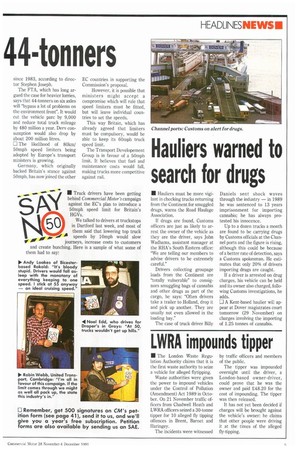Dip hints at move to 44-tonners
Page 6

Page 7

If you've noticed an error in this article please click here to report it so we can fix it.
• Transport Minister Roger Freeman has hinted that the Government will allow 44-tonne trucks if it wins the next election.
At a conference last week he said that ministers might soon have to confront public opposition on heavier trucks and persuade the electorate of the possible environmental benefits of having fewer LGVs on the road.
"Should we be facing up to public approbation on higher weights? The dimensions and axle loadings would not change," he told the conference, hosted by environmental pressure group Transport 2000.
He reported that the increase from 32 tonnes to 38 tonnes in 1983 had reduced the number of trucks on the road — but added that "our present policy is that we are not shifting off 38 tonnes".
There are growing signs that 44 tonnes will be introduced, no matter who wins the election. Shadow Transport Secretary John Prescott has told the Freight Transport Association that he supports 44-tonners, subject to routeing restrictions.
This week Prescott's office told Commercial Motor that it is in favour of 40 and 44-tonne trucks on six axles, but that a strategic network of routes needs to be planned, with bridges strengthened to take heavier trucks and bypasses to avoid villages.
Transport Secretary Malcolm Rifkind has already promised a review of lorry weights after the election.
The Government's present stance is that it will not permit an increase in weights until the end of the decade, when its bridge-strengthening programme is due to be completed.
Even Transport 2000 is talking privately of a change in policy to accept 44 tonnes, although it still argues against the claimed environmental advantages of heavier trucks. The HGV parc has increased by more than 5% since 1983, according to director Stephen Joseph.
The PTA, which has long argued the case for heavier lorries, says that 44-tanners on six axles will "bypass a lot of problems on the environment front". It would cut the vehicle parc by 9,000 and reduce total truck mileage by 480 million a year. Dery consumption would also drop by about 200 million litres.
ID The likelihood of 80km/ 50mph speed limiters being adopted by Europe's transport ministers is growing.
Germany, which originally backed Britain's stance against 50mph, has now joined the other EC countries in supporting the Commission's proposal.
However, it is possible that ministers might accept a compromise which will rule that speed limiters must be fitted, but will leave individual countries to set the speeds.
This way Britain, which has already agreed that limiters must be compulsory, would be able to keep its 60mph truck speed limit.
The Transport Developement Group is in favour of a 50mph limit. It believes that fuel and maintenance costs would fall, making trucks more competitive against rail.


























































































